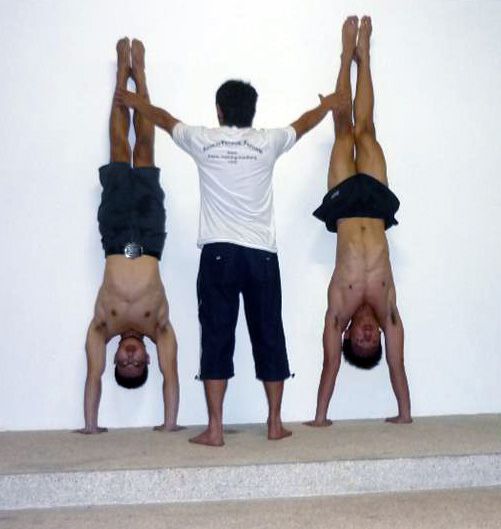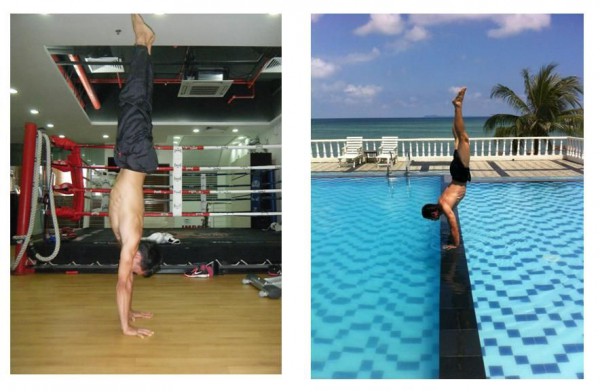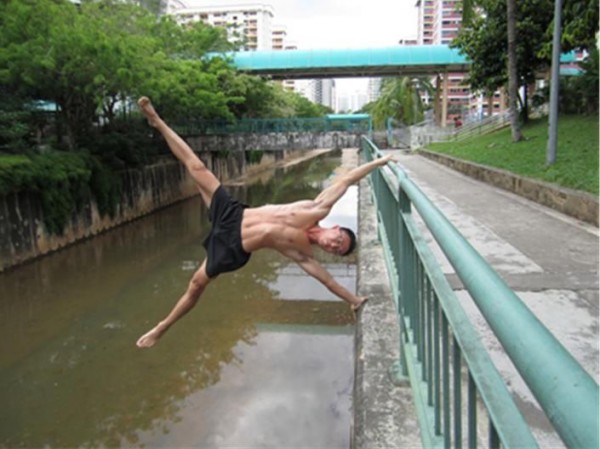 If you are reading this blog, chances are you are looking to make some physical improvements to yourself – e.g. you want to be able to run faster, or to jump higher, or to churn out amazing feats of strength, etc.
If you are reading this blog, chances are you are looking to make some physical improvements to yourself – e.g. you want to be able to run faster, or to jump higher, or to churn out amazing feats of strength, etc.
Being able to do and hold a straight handstand for one solid minute will aid in all-round athletic development.
But before we begin, let us first take a look at a couple of handstand photos.
 Even though there is no one “perfect” handstand form, so to speak, the straight handstand that we are talking about here should approximate the one shown in the picture on the left, as opposed to and contrasted with the handstand depicted in the picture on the right.
Even though there is no one “perfect” handstand form, so to speak, the straight handstand that we are talking about here should approximate the one shown in the picture on the left, as opposed to and contrasted with the handstand depicted in the picture on the right.
Essentially, a straight handstand should find the back flat, with no arch in the lower back. The major limbic joints of the body, i.e. the wrists, elbows, shoulders, hips, knees, and ankles should find themselves “stacked”.
The reason for the difference between a straight handstand and an arched one is also the reason why being able to do and hold the former is going to make you stronger and more coordinated.
The key word here is “tension”.
In order to perform a handstand, as with any other physical feat, one requires some level of bodily strength. If you are able to stand and balance using your arms, just imagine the kind of strength, coordination and body awareness that you will achieve.
In a straight handstand, the entire body is tensed in a coordinated manner, with the exception of the facial and neck muscles. We are talking about conscious muscle engagement (you are using it, not just training) to hold this unnatural position, it makes subsequent hand balancing elements ‘easier’ to learn. When one finds his or her lower back arching in a handstand, chances are that some parts of the body are not being engaged as needed to achieve the straight form, or some structural issues subsist that makes the straight form difficult to achieve.
The ability to generate and hold this muscular tension throughout the body such that a straight handstand is achieved comprises two key ingredients: coordinated strength and body awareness.
Our legs are strong not only because they make up a large part of our bodies; it is also because we tend to stand a lot. We are able to stand on our feet so well because we have been doing it since we were little. Using the concept of perceived effort level (PEL), over time as your musculature has been doing prolonged hours of work keeping you standing upright, you get so used to it that you stop perceiving this effort level as an undue strain or demand. Of course, we don’t remember much from when we were really little. Otherwise, you might have recalled that learning to stand was a real pain.
The same broad principles apply in the handstand. Because the handstand is a relatively new and somewhat unnatural position for those of you who are not acquainted with it, you are going to find it terribly difficult, at least initially, to tense your body in the requisite manner while trying to hold it in the air, on your hands. This is normal, and only to be expected.
And, make no mistake, the handstand, especially the straight handstand, is a powerful physical tool that unlocks many doors in the realm of physical fitness and culture.
You will get stronger from holding your handstand. This is because the tension that your body generates and maintains while you are performing a handstand is an exertion of strength.
Through the practice of handstands, we learn to generate muscular tension in some pretty challenging circumstances. Which means to say, the finer balance involved while you’re standing on your hands will compel you to tense your muscles harder than when you are standing on your feet. What this in turn means is that you are able to contract your muscles rather powerfully, and hold this contraction over a certain period of time.
Speak to any strong power lifter and he or she will tell you to brace your trunk while you are lifting. The act of bracing the musculature in the torso is a cornerstone of the ability to move some serious weight. Bracing is a requirement for a straight handstand and can be translated into the other athletic disciplines or types of movement that you may be interested in.
Since your hands are smaller than your feet (pardon my presumption if this isn’t true for you), and they lack a proper heel that would allow for effective balance in the direction away from your fingers, you will find that in holding a handstand you will be needing to perform many micro-adjustments in your musculature as a form of re-balancing exercise in order to continue staying on your hands.
When all is said and done, while the handstand is not going to make you as strong as the Hulk, or as finely-balanced and superbly-coordinated as Spiderman; but what it is going to give you is a sound foundation upon which these traits can be more readily built and refined.
Envisioning your body in space while holding an inverted position on your hands helps with development your body awareness, in terms of muscular effort and proprioception. For those of you dreaming of flags and front levers and the like, all these skills share a similar trait that requires full-body tension as in the handstand. Main point of difference – since in a flag or a front lever, or a back lever or a planche, your major limbic joints are not going to be as stacked under your bodyweight as in the handstand, they are going to require far greater and more specific arm and shoulder strength in varying scapular positions.
 For a novice, the tremendous arm and shoulder strength required for a proper planche or lever isn’t going to come as quickly as is hoped. Tensing the body while struggling to hold a desired position is often nigh on impossible. That is why one should start with the handstand if one aspires to these other skills – the handstand, by the law of simple physics, does not require the same staggering levels of arm and shoulder strength. Learning it will teach you the body tension that will then stand you in good stead as you pursue the other static strength holds.
For a novice, the tremendous arm and shoulder strength required for a proper planche or lever isn’t going to come as quickly as is hoped. Tensing the body while struggling to hold a desired position is often nigh on impossible. That is why one should start with the handstand if one aspires to these other skills – the handstand, by the law of simple physics, does not require the same staggering levels of arm and shoulder strength. Learning it will teach you the body tension that will then stand you in good stead as you pursue the other static strength holds.
Often, the exertion of the scapular complex to fight the pull of gravity in a lever or flag or planche is going to be rendered extremely challenging if the body is not tensed. A loose and sagging torso and legs represent far greater resistance by leverage than a torso and legs that are powerfully-tensed/engaged. Acquiring the ability and the capacity for this tension in the handstand will greatly expedite the learning process for the other, more strength-demanding, exercises.
On a side note, even if the freestanding handstand is not your goal, hand balancing training has benefits which should not be overlooked. Hand balancing training is more than just kicking up onto the wall and holding for time. The alignment and balance drills and flexibility training will help with many of the mobility issues faced by the individual on a daily basis.
Due to the nature of the practice, hand balancing training helps with shoulder health and strength. Strength and health should go hand in hand unlike today where the pursuit of one aspect (usually strength) solely results in poor long term health (joint problems, imbalances etc).
***
Post is Co-written by Lionel Ng and Bruce Dierl of Basic Training Academy. Credit to Ling Qinghu, ex-acrobat from the Fujian Acrobatic Troupe, for teaching me (Bruce) the fundamental principles behind the handstand. Credit to Yuval Ayalon, former gymnast and former Le Reve performer for his guidance in understanding the finer intricacies of hand balancing. Bruce and Lionel previously attended a workshop by Ido Portal.